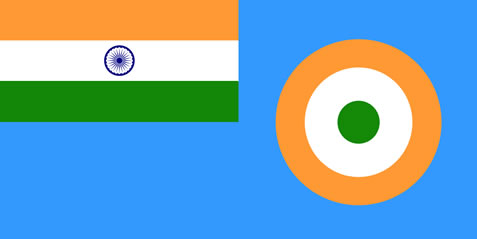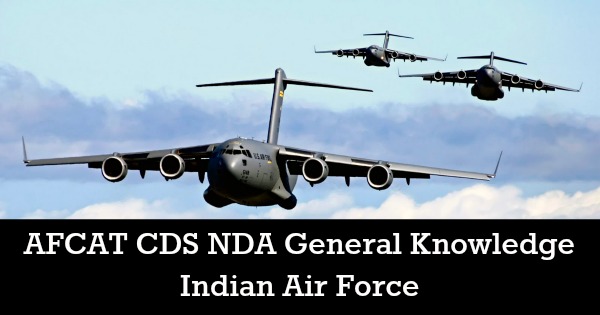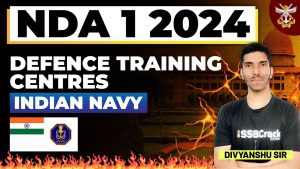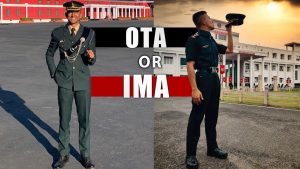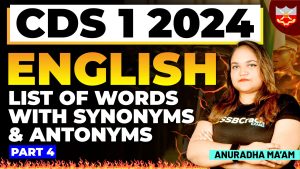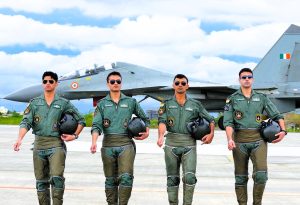- Formation of Indian Air Force
The Indian Air Force’s History precedes World War Two by eight years. The IAF was established by on 8 Oct 1932 when its formation was announced in the Gazette of India. No.1 Squadron formed at Drigh Road in Karachi on 1 April 1933 with a complement of six Indian Officers under the command of a British Officer.
Formation and early pilot
The Indian Air Force was established in British India as an auxiliary air force of the Royal Air Force with the enactment of the Indian Air Force Act 1932 on 8 October that year and adopted the Royal Air Force uniforms, badges, brevets and insignia. On 1 April 1933, the IAF commissioned its first squadron, No.1 Squadron, with four Westland Wapiti biplanes and five Indian pilots. The Indian pilots were led by RAF Commanding officer Flight Lieutenant (later Air Vice Marshal) Cecil Bouchier.
- Motto of Indian Air Force
The Motto of Indian Air Force has been taken from eleventh chapter of the Gita, the Discourse given by Lord Krishna to Arjuna on the battlefield of Kurukshetra during the Great War of Mahabharata. The Lord is showing His Supreme Divine form to Arjuna and the great form of the Lord is reaching the sky with glory, evoking fear and loss of self-control in the mind of Arjuna.The Indian Air Force, similarly, aims to overwhelm the adversaries with application of aerospace power in defence of the nation.
- Flag of Indian Air Force
AFCAT CDS NDA General Knowledge Indian Air Force
- Contribution and Service by Indian Air Force
World War II (1939–1945)
During World War II, the IAF played an instrumental role in blocking the advance of the Japanese army in Burma, where its first air strike was on the Japanese military base in Arakan. It also carried out strike missions against the Japanese airbases at Mae Hong Son, Chiang Mai and Chiang Rai in northern Thailand.
The IAF was mainly involved in Strike, Close Air Support, Aerial reconnaissance, Bomber Escort and Pathfinding missions for RAF and USAAF Heavy bombers. RAF Pilots were embedded in IAF units and vice versa to gain combat experience. IAF pilots participated in air operations in Europe as part of the RAF.[18]
During the war, the IAF went through a phase of steady expansion. New aircraft, including the U.S. built Vultee Vengeance, Douglas DC-3 and the British Hawker Hurricane, Supermarine Spitfire and Westland Lysander, were added to its fleet.
In recognition of the services rendered by the IAF, King George VI conferred the prefix “Royal” in 1945. Thereafter the IAF was referred to as the Royal Indian Air Force. In 1950, when India became a republic, the prefix was dropped and it reverted to being the Indian Air Force.
First years of independence (1947–1950)
After become independent from the British Empire in 1947, British India was partitioned into the new states of the Dominion of India and the Dominion of Pakistan. Along the lines of the geographical partition, the assets of the air force were divided between the new countries. India’s air force retained the name of the Royal Indian Air Force, but three of the ten operational squadrons and facilities, located within the borders of Pakistan, were transferred to the Royal Pakistan Air Force.[19] The RIAF Roundel was changed to an interim ‘Chakra’ roundel derived from the Ashoka Chakra.
Around the same time, conflict broke out between them over the control of the princely state of Jammu & Kashmir. With Pakistani forces moving into the state, its Maharaja decided to accede to India in order to receive military help. The day after, the Instrument of Accession was signed, the RIAF was called upon to transport troops into the war zone. And this was when a good management of logistics came into help. This led to the eruption of full-scale war between India and Pakistan, though there was no formal declaration of war. During the war, the RIAF did not engage the Pakistan Air Force in air-to-air combat; however, it did provide effective transport and close air support to the Indian troops.
Kargil War (1999)
On 11 May 1999, the Indian Air Force was called in to provide close air support to the Indian Army at the height of the ongoing Kargil conflict with the use of helicopters.The IAF strike was code named Operation Safed Sagar. The first strikes were launched on 26 May, when the Indian Air Force struck infiltrator positions with fighter aircraft and helicopter gunships. The initial strikes saw MiG-27s carrying out offensive sorties, with MiG-21s and later MiG-29s providing fighter cover. The IAF also deployed its radars and the MiG-29 fighters in vast numbers to keep check on Pakistani military movements across the border. Srinagar Airport was at this time closed to civilian air-traffic and dedicated to the Indian Air Force.
On 27 May, the Indian Air Force suffered its first fatality when it lost a MiG-21 and a MiG-27 in quick succession. The following day, while on an offensive sortie, a Mi-17 was shot down by three Stinger missiles and lost its entire crew of four. Following these losses the IAF immediately withdrew helicopters from offensive roles as a measure against the threat of Man-portable air-defence systems (MANPAD). On 30 May, the Mirage 2000s were introduced in offensive capability, as they were deemed better in performance under the high-altitude conditions of the conflict zone. Mirage 2000s were not only better equipped to counter the MANPAD threat compared to the MiGs, but also gave IAF the ability to carry out aerial raids at night. The MiG-29s were used extensively to provide fighter escort to the Mirage 2000. Radar transmissions of Pakistani F-16s were picked up repeatedly, but these aircraft stayed away. The Mirages successfully targeted enemy camps and logistic bases in Kargil and severely disrupted their supply lines. Mirage 2000s were used for strikes on Muntho Dhalo and the heavily defended Tiger Hill and paved the way for their early recapture. At the height of the conflict, the IAF was conducting over forty sorties daily over the Kargil region. By 26 July, the Indian forces had successfully repulsed the Pakistani forces from Kargil.
- Structure of Indian Air Force
The President of India is the Supreme Commander of all Indian armed forces and by virtue of that fact is the national Commander-in-chief of the Air Force. Chief of the Air Staff with the rank of Air Chief Marshal is the Commander of the Indian Air Force. He is assisted by six officers, all with the rank of Air Marshal:
- Vice Chief of the Air Staff
- Deputy Chief of the Air Staff
- Air Officer in Charge of Administration
- Air Officer in Charge of Personnel
- Air Officer in Charge of Maintenance
- Director General of Inspection and Flight Safety.
Operational Commands
- Central Air Command (CAC), headquartered at Allahabad, Uttar Pradesh
- Eastern Air Command (EAC), headquartered at Shillong, Meghalaya
- Southern Air Command (SAC), headquartered at Thiruvananthapuram, Kerala
- South Western Air Command (SWAC), headquartered at Gandhinagar, Gujarat
- Western Air Command (WAC), headquartered at New Delhi
Functional Commands
- Training Command (TC), headquartered at Bangalore, Karnataka
- Maintenance Command (MC), headquartered at Nagpur, Maharashtra
Wings
A Wing is a formation intermediate between a Command and a Squadron. It generally consists of two or three IAF Squadrons and Helicopter Units, along with Forward Base Support Units (FBSU). FBSUs do not have or host any Squadrons or Helicopter units but act as transit airbases for routine operations. In times of war, they can become fully fledged air bases playing host to various Squadrons. In all, about 47 Wings and 19 FBSUs make up the IAF. Wings are typically
Squadrons and Units
Squadrons are the field units and formations attached to static locations. Thus, a Flying Squadron or Unit is a sub-unit of an air force station which carries out the primary task of the IAF. A fighter squadron consists of 18 aircraft; all fighter squadrons are headed by a Commanding Officer with the rank of Wing Commander. Some Transport squadrons and Helicopter Units are headed by a Commanding Officer with the rank of Group Captain.
Sections
The smallest unit is the section, led by a Flight Lieutenant. Each section consists of three aircraft.
Within this formation structure, IAF has several service branches for day-to-day operations. They are:
Flying Branch
|
Technical Branch
|
Ground Branch
|
CDS 2 2016 Exam Online Coaching
AFCAT 2 2016 Online Coaching
NDA 2016 Online Coaching
- Rank structure of Indian Air Force
The rank structure of the Indian Air Force is based on that of the Royal Air Force. The highest rank attainable in the IAF is Marshal of the Indian Air Force, conferred by the President of India after exceptional service during wartime. MIAF Arjan Singh is the only officer to have achieved this rank. The head of the Indian Air Force is the Chief of the Air Staff, who holds the rank of Air Chief Marshal.
Officers
- List of Indian Air Force Medals and Awards
- PARAM VIR CHAKRA
Circular in shape, made of bronze, one and three eighth inches in diameter and on obverse, four replicas of “Indra’s Vajra” with the State Emblem (including the motto), embossed in the centre. On its reverse, it shall have embossed Param Vir Chakra both in Hindi and English with two lotus flowers between Hindi and English. The fitting will be swivel mounting.
- MAHAVIR CHAKRA
The following categories of personnel shall be eligible for the Chakra :-
- Officers, men and women of all ranks of the Army, the Navy and the Air Force, of any of the Reserve Forces, of the Territorial Army, Militia and of any other lawfully constituted Armed Forces.
- Matrons, Sisters, Nurses and the staff of the Nursing Services and other Services pertaining to Hospitals and Nursing and Civilians of either sex serving regularly or temporarily under the orders, directions or supervision of any of the above-mentioned Forces.
- ASHOKA CHAKRA
The following categories of personnel shall be eligible for the Chakra :-
- Officers, men and women of all ranks of the Army, the Navy and the Air Force, of any of the Reserve Forces, of the Territorial Army, Militia and of any other lawfully constituted Armed Forces.
- Members of the Nursing Services of the Armed Forces.
- Civilian citizens of either sex in all walks of life and members of Police Forces including Central Para-Military Forces and Railway Protection Force.
- KIRTI CHAKRA
The following categories of personnel shall be eligible for the Chakra :-
- Officers, men and women of all ranks of the Army, the Navy and the Air Force, of any of the Reserve Forces, of the Territorial Army, Militia and of any other lawfully constituted Armed Forces.
- Members of the Nursing Services of the Armed Forces.
- Civilian citizens of either sex in all walks of life and members of Police Forces including Central Para-Military Forces and Railway Protection Force.
- VIR CHAKRA
The following categories of personnel shall be eligible for the Chakra :-
- Officers, men and women of all ranks of the Army, the Navy and the Air Force, of any of the Reserve Forces, of the Territorial Army, Militia and of any other lawfully constituted Armed Forces.
- Matrons, Sisters, Nurses and the staff of the Nursing Services and other Services pertaining to Hospitals and Nursing and Civilians of either sex serving regularly or temporarily under the orders, directions or supervision of any of the above-mentioned Forces.
- SHAURYA CHAKRA
The following categories of personnel shall be eligible for the Chakra :-
- Officers, men and women of all ranks of the Army, the Navy and the Air Force, of any of the Reserve Forces, of the Territorial Army, Militia and of any other lawfully constituted Forces.
- Members of the Nursing Services of the Armed Forces.
- Civilian citizens of either sex in all walks of life and members of Police Forces including Central Para-Military Forces and Railway Protection Force.
- SARVOTTAM YUDH SEVA MEDAL
The following categories of personnel shall be eligible for the medal: –
- All ranks of the Army, the Navy and the Air Force including those of Territorial Army Units, Auxiliary and Reserve Forces and other lawfully constituted Armed Forces when embodied.
- Nursing officers and other members of the Nursing Services in the Armed Forces.
- UTTAM YUDH SEVA MEDAL
The following categories of personnel shall be eligible for the medal :-
- All ranks of the Army, the Navy and the Air Force including those of Territorial Army Units, Auxiliary and Reserve Forces and other lawfully constituted Armed Forces when embodied.
- Nursing officers and other members of the Nursing Services in the Armed Forces.
- YUDDH SEVA MEDAL
The following categories of personnel shall be eligible for the award of the Medal:-
- All ranks of the Army, the Navy and the Air Force including Territorial Army Units, Auxiliary and Reserve Forces (when embodied) and other lawfully constituted Armed Forces.
- Nursing officers and other members of the Nursing Services in the Armed Forces.
- PARAM VISHISHT SEVA MEDAL
The following categories of personnel shall be eligible for the medal :-
- All ranks of the Army, the Navy and the Air Force including Territorial Army Units, Auxiliary and Reserve Forces (when embodied) and other lawfully constituted Armed Forces.
- Nursing officers and other members of the Nursing Services in the Armed Forces.
- ATI VISHISHT SEVA MEDAL
The following categories of personnel shall be eligible for the medal :-
- All ranks of the Army, the Navy and the Air Force including Territorial Army Units, Auxiliary and Reserve Forces (when embodied) and other lawfully constituted Armed Forces.
- Nursing officers and other members of the Nursing Services in the Armed Forces.
- VISHISHT SEVA MEDAL
The following categories of personnel shall be eligible for the medal :-
- All ranks of the Army, the Navy and the Air Force including Territorial Army Units, Auxiliary and Reserve Forces (when embodied) and other lawfully constituted Armed Forces.
- Nursing officers and other members of the Nursing Services in the Armed Forces.
- VAYU SENA MEDAL
The following categories of personnel shall be eligible for the award of the Medal:-
- Officers and airmen of the Regular Air Force and officers and airmen of Auxiliary Air Force, Air Defence Reserve and Regular Reserve when called upon under Section 25 of the Reserve and Auxiliary Air Force Act, 1952.
- Army officers serving as pilots in Aviation Corp. will also be eligible for the award of this Medal.


